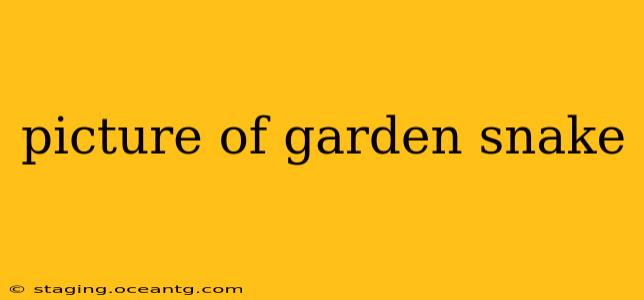Decoding the Garden Snake: A Comprehensive Guide to Identification and Coexistence
The term "garden snake" is often used loosely to describe several non-venomous snake species frequently found in gardens and yards. This guide aims to clarify the identification of common garden snakes and address some frequently asked questions about their behavior and how to coexist peacefully. Understanding these slithery friends can help alleviate fear and foster appreciation for their role in the ecosystem.
What are some common garden snakes?
This depends heavily on geographic location. There isn't one single "garden snake" species. However, several snake species are commonly referred to as "garden snakes" due to their frequent presence in gardens. These often include species within the Thamnophis genus (garter snakes), Opheodrys (smooth green snakes), and various other non-venomous colubrids. Identifying the specific species requires careful observation of characteristics like size, coloration, and pattern. Reliable regional field guides are invaluable for precise identification.
What do garden snakes look like?
The appearance of a "garden snake" varies dramatically depending on the species. However, many share common traits:
- Size: Most garden snakes are relatively small to medium-sized, typically ranging from 1 to 4 feet in length.
- Coloration: Colors range greatly, from browns, greens, and grays to more vibrant combinations incorporating red, black, and yellow stripes or patterns. Some have smooth scales, while others have keeled (ridged) scales.
- Pattern: Patterns can be stripes, bands, or blotches. The pattern, along with coloration, is crucial for accurate species identification.
How can I tell the difference between a garden snake and a venomous snake?
Accurately distinguishing between venomous and non-venomous snakes requires careful observation and ideally, knowledge from reputable sources like field guides or herpetologists. There are no universally reliable "rules" to distinguish them. However, some characteristics can be helpful, but should never be relied upon alone for identification:
- Pupil Shape: Venomous snakes often have elliptical or cat-like pupils, while non-venomous snakes generally have round pupils. However, there are exceptions.
- Head Shape: Some venomous snakes have triangular heads, but again, this is not a reliable indicator.
- Body Shape: Venomous snakes can have a heavier body build.
It's critical to emphasize: Never attempt to handle a snake if you are unsure of its identity. If you encounter a snake you suspect is venomous, maintain a safe distance and contact your local wildlife authorities or a professional herpetologist for assistance.
What do garden snakes eat?
Garden snakes are primarily insectivores, meaning their diet consists largely of insects. Their diet may also include other small invertebrates like slugs, snails, and earthworms. Some larger species may also consume small rodents or amphibians. Their role as insectivores makes them beneficial to gardens by controlling pest populations.
Are garden snakes dangerous?
The vast majority of snakes referred to as "garden snakes" are completely harmless to humans. They are not venomous and pose no threat beyond a very slight potential for a bite if handled roughly. Their bite, if it occurs, would be comparable to a minor pinprick.
How can I encourage garden snakes in my garden?
Creating a habitat that is favorable to garden snakes can help ensure their presence, which in turn provides natural pest control. This includes:
- Providing cover: Rocks, logs, dense vegetation, and leaf litter provide hiding places.
- Maintaining a water source: A small birdbath or other water source provides essential hydration.
- Avoid pesticides: Using pesticides can reduce insect populations, diminishing a food source for snakes.
- Leave some areas undisturbed: Avoid excessively manicuring your yard. Some unkempt areas can provide ideal habitat.
By understanding the characteristics, behaviors, and ecological role of garden snakes, we can foster a harmonious coexistence between humans and wildlife in our gardens and yards. Remember, reliable identification is crucial for safe interactions, so consult reputable resources for species-specific information in your region.
